A solid CRM strategy is essential for optimizing sales and marketing performance. With the right tactics to complement your tools and talent, you’ll be one step closer to outperforming your competitors.
In this article, we’ll explain what a CRM strategy is and how to build one for revenue growth. We’ll also share step-by-step instructions and some real-world examples of successful CRM strategies to help you maximize the value of every buyer interaction.
Key takeaways
A CRM strategy is a structured plan that helps SMBs manage customer relationships, align teams and drive sustainable business growth.
Implementing a CRM strategy improves efficiency, customer retention, collaboration and profitability across sales and marketing.
Many SMBs struggle with disorganized data and inconsistent communication, but a clear CRM strategy centralizes information and streamlines workflows.
CRM tools like Pipedrive make executing your strategy simple with automation, data insights and pipeline visibility – start your free 14-day trial today.
What is CRM strategy and do you need one?
A customer relationship management (CRM) strategy is a company-wide plan for maximizing the value of customer relationships, with the aim of reducing costs and increasing profit.
SMBs need a CRM strategy because it’s one of three factors that contribute to successful customer relationship management:
Tools. The technologies you use to organize customer data, track internal performance and manage relationships. Pipedrive is a prime example of sales CRM software.
Talent. The people within your business who use those tools to manage data and make revenue-generating decisions. They’re typically members of sales, marketing, customer satisfaction or customer service teams.
Strategy. How you apply your tools and talent to get results and how the execution separates you from your competition.
The right CRM strategy framework covers many activities, from organizing customer data and aligning sales and marketing teams to planning content and tracking its performance.
Completing these sales activities in a thoughtful, insight-driven way allows you to:
Provide meaningful customer experiences at every stage of the buyer journey
Target your marketing campaigns for a better return on investment (ROI)
Easily identify the most valuable sales leads so reps can act quickly
Avoid repeating sales and marketing mistakes
Rather than copying another company’s CRM plan, build yours from the ground up and tailor it to your audience’s needs and business goals. That said, outside inspiration is always helpful (you’ll find three real-world examples at the end of this guide).
What to include in an effective CRM strategy
A CRM strategy defines how your business will use CRM tools to attract, engage and retain clients more effectively.
For SMBs, this strategy ensures every interaction contributes to growth, efficiency and long-term customer loyalty.
Your CRM strategy should include:
Clear business goals | Identify SMART goals, such as improving customer retention, shortening sales cycles or increasing lead conversion rates. |
Define your target audiences and segment them based on behavior, preferences or purchase history to personalize communication. | |
Workflow and marketing automation | Determine which tasks (like lead follow-ups, email outreach or customer onboarding) can be automated to save time and reduce errors. |
Data management framework | Establish how to collect, store and update customer data to maintain accuracy and compliance. |
Team roles and accountability | Clarify responsibilities for managing leads, updating records and tracking performance to ensure consistency across departments. |
Connect your CRM with marketing, accounting and support tools for a unified view of your customers and operations. | |
Use dashboards and reports to monitor key metrics, review progress and refine your business strategy for better results. |
A well-defined CRM strategy helps SMBs stay organized and deliver better customer experiences. An effective strategy also helps sales teams with accurate forecasting and revenue predictions, allowing them to make smarter, data-driven business decisions.
5 steps for building an effective CRM strategy
A good CRM strategy starts with a clear plan that organizes customer data, aligns teams and drives measurable business results.
Follow this five-step CRM planning process to ensure every action supports your business goals.
1. Review your performance objectives
An effective CRM strategy must contribute to high-level business objectives.
Start by considering what your company wants to achieve (it’s unlikely to be as simple as “selling more products”) and how customer relationships support that. You can then plan specific actions that contribute to the desired outcome.
Say a software company aims to cut marketing costs. Better targeting ensures they maximize advertising spend by reaching the right people (i.e., those likely to get long-term value from the product).
A thoughtful loyalty plan also keeps new customers satisfied and engaged. Both tactics would contribute to the wider objective by reducing churn rates.
Pipedrive’s CRM makes it easy to track and manage performance objectives by letting you set measurable goals, monitor deal progress and visualize team performance in real time.
For example, here’s how to visualize deal progress in a sales pipeline:
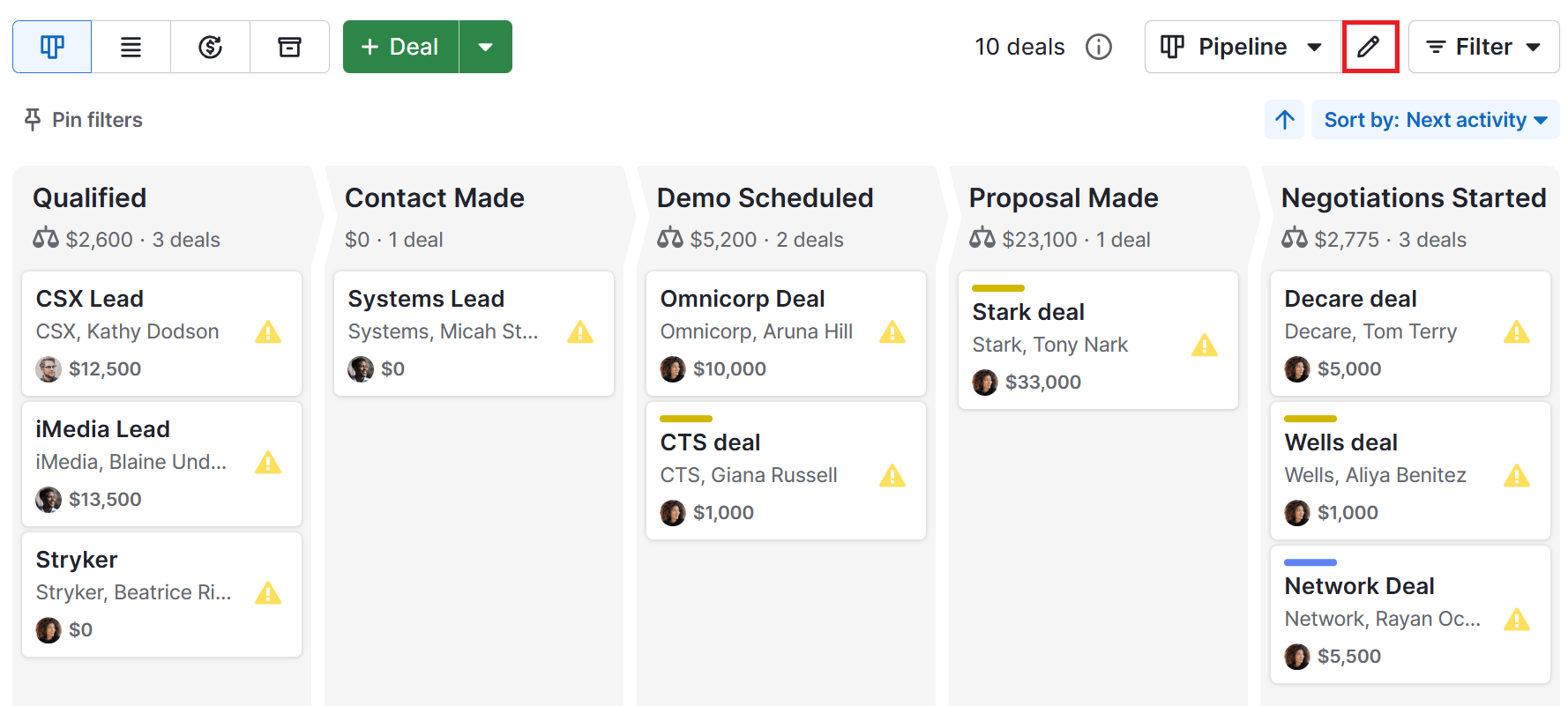
This pipeline view shows how deals move through each stage of your sales process. As a result, you can quickly identify bottlenecks, stalled opportunities and where adjustments are needed to keep deals on track.
2. Audit your contact data (and keep it organized)
Audit your contact data to ensure all lead, customer and team information is accurate, organized and ready to drive smarter CRM decisions.
Review your tech stack and identify whether you’re collecting data from the following sources as part of your standard business processes:
Website analytics (e.g., Google Analytics)
Email marketing analytics (e.g., Campaigns by Pipedrive)
Competition entries
Customer interactions on social media
Customer support inquiries
Sales team performance reviews
When you know where your contact data is and comes from, you can:
Organize it. Make the data accessible to people who can use it to make better decisions.
For example, if your website consistently generates valuable leads, start funneling their contact information into your CRM tool so that all sales reps have a ready-made prospecting list.
You gather lead info automatically with Pipedrive’s LeadBooster and Leads Inbox features:
Prioritize it. Highlight the types of data most valuable to your business and stop collecting the information you don’t need.
For example, if email marketing works well for you, focus on email addresses and anything that’ll help you segment your audience for more personalized interactions, such as demographic data and website activity.
Here’s an example of a segmented audience in Pipedrive based on where they are in the buying journey (cold, warm or hot):

Enrich it. Fill customer data gaps for a clear and detailed view of your audience.
For example, you might already have a lead’s name and email address in your CRM. By pulling information from LinkedIn, you could add their employer, job title and location.
The clearer the picture, the easier it’ll be to personalize sales and marketing interactions.
You can easily enrich and update contact information in Pipedrive. Here’s an example of some of the customer data you can store and edit in the software:
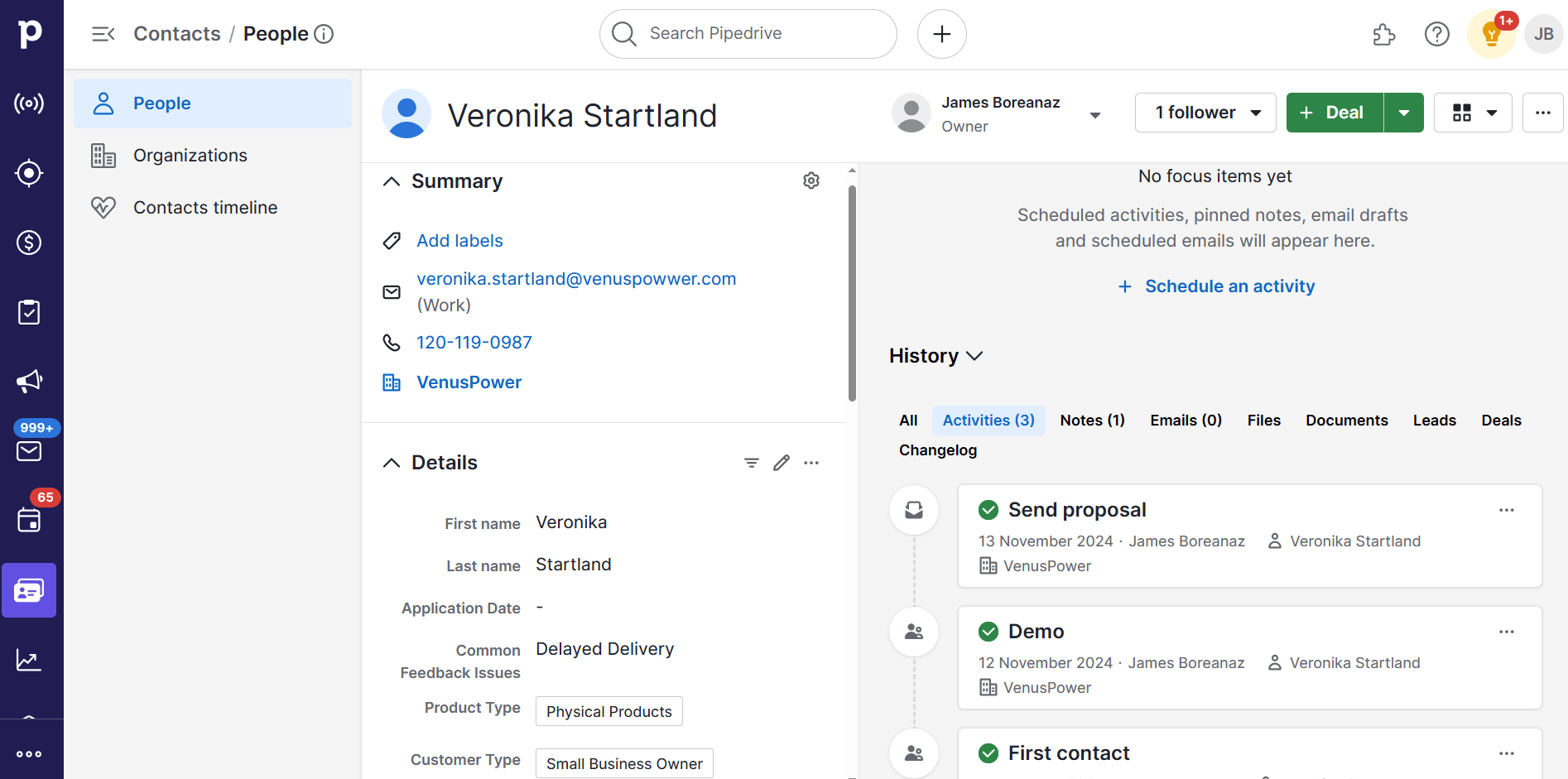
Collect more. Once you have a plan for your data and a process for organizing it, you can start collecting with purpose.
Incorporate more sources to populate your CRM solution with real-time data that’ll help you reach the right people with the right messages.
3. Refine your buyer personas and ideal customer profiles
Use your rejuvenated data to revisit your buyer personas and ideal customer profiles (ICPs).
These two terms mean different things but are both important to your CRM strategy.
An ICP defines the perfect customer for your business on an organizational level, based on factors like budget, revenue, company size, location and any product or service limitations.
For example, a software-as-a-service (SaaS) firm might target US marketing agencies with revenue above $10 million, annual sales software budgets of $20,000–$40,000 and more than 40 employees.
Here’s an example of an ICP template in Pipedrive:
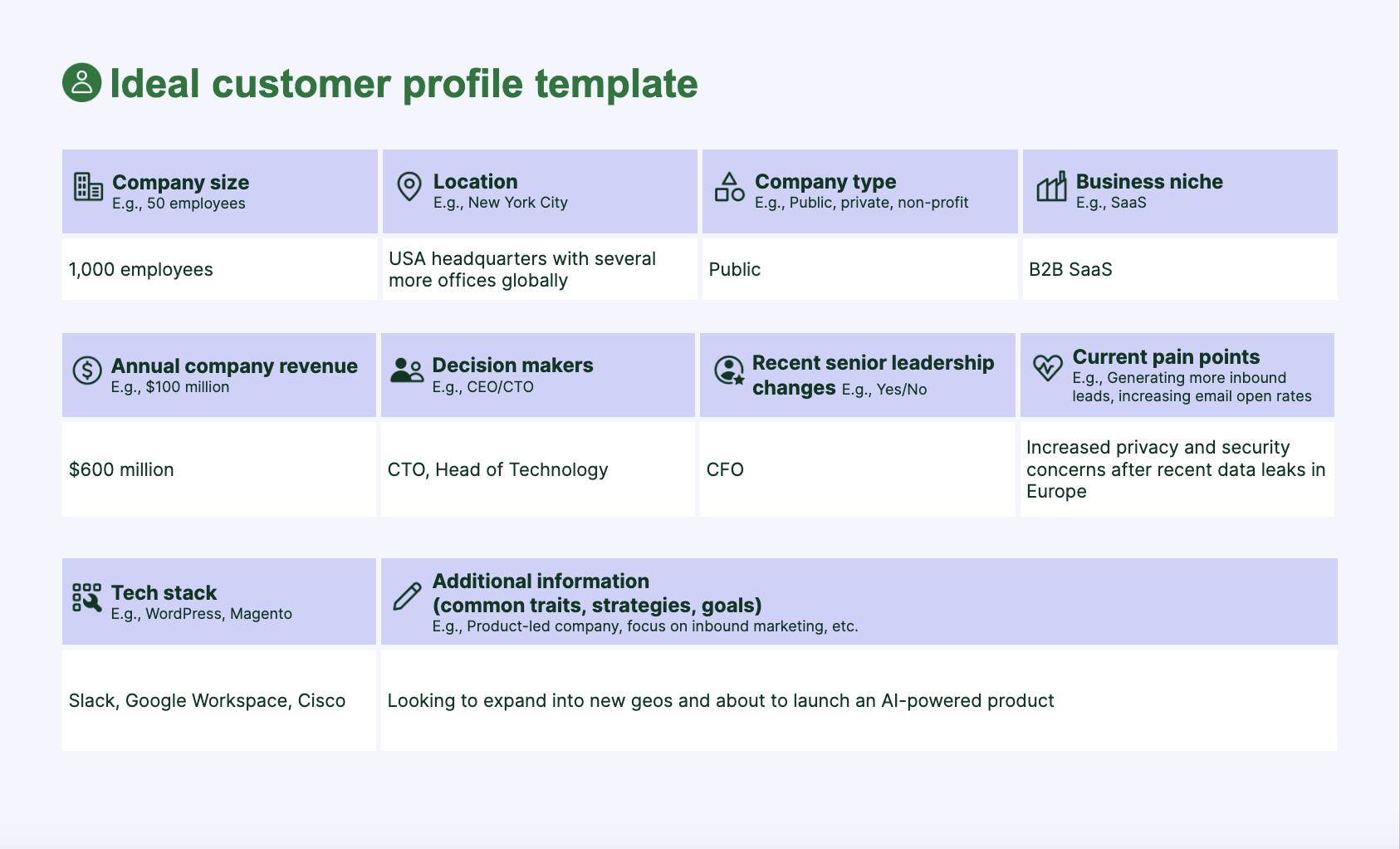
Use this template to define your ideal audience, allowing you to tailor sales and marketing efforts to the prospects most likely to convert.
A buyer persona focuses more on describing the characteristics of an individual sales prospect, like their demographics, pain points, location, values and goals.
The SaaS company’s buyer persona could be a marketing manager with a goal to reduce company spending and whose biggest pain point is having inconsistent customer data stored in multiple locations.
Better understand your customers with our Buyer Persona Templates
ICPs and buyer personas help you and your team understand exactly who you should be talking to at the various marketing and sales touchpoints and how best to engage them.
4. Map your sales pipeline
A sales pipeline is an organized, visual representation of your sales process that tracks potential buyers as they progress through different stages of the customer journey.
For example, the image below shows the pipeline view in Pipedrive, which visualizes users’ different deals and the status of each.
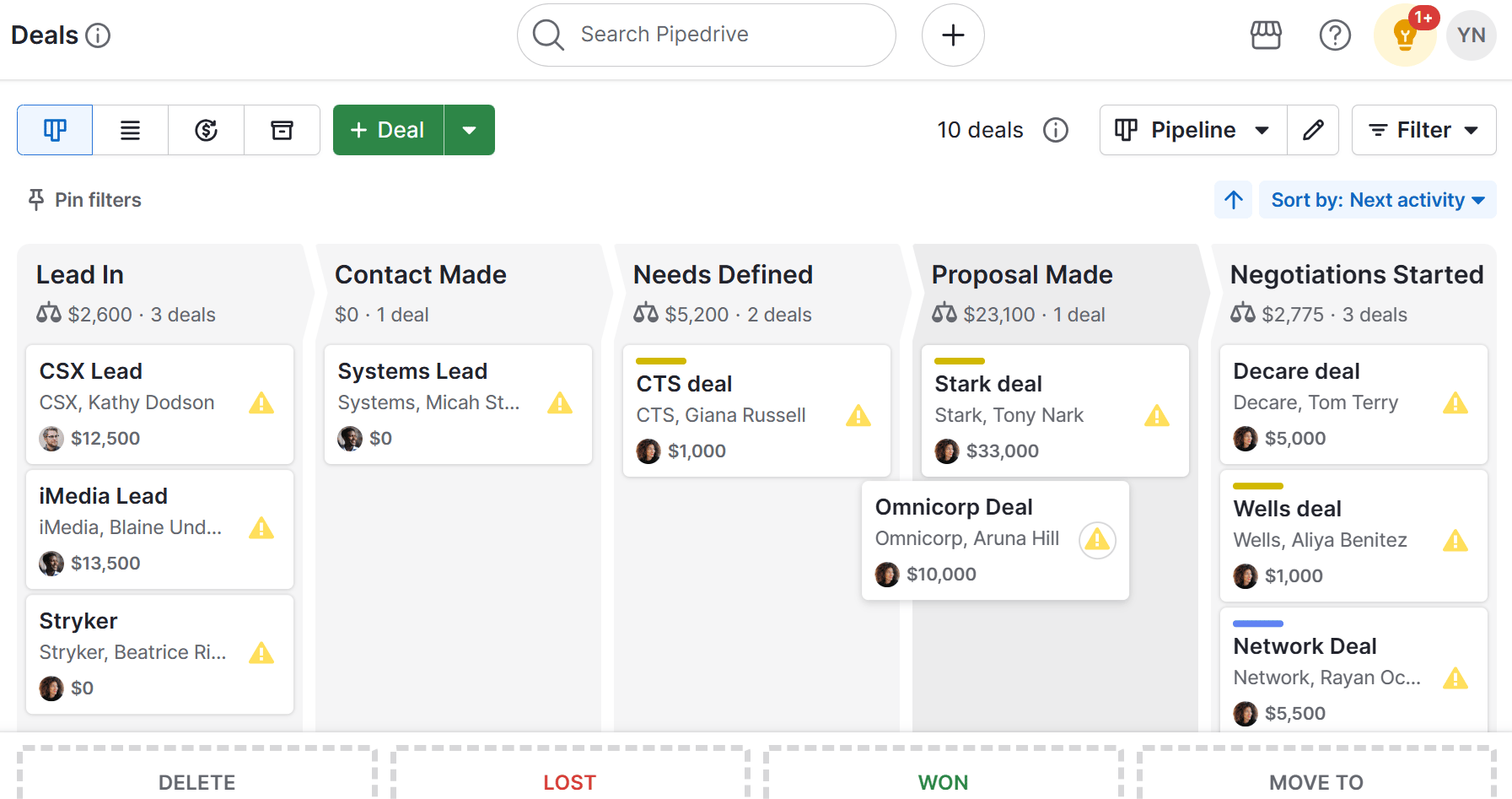
In addition to adding a layer of accountability for reps, the pipeline enables sales leaders to collate and analyze data on how well their sales process is working so they can optimize it.
Say the sales pipeline shows that deals often go cold during negotiation. In this scenario, the sales manager or business owner could:
Reassess product prices
Change how leads are distributed to sales reps
Implement negotiation training for the team
A visual sales pipeline will help you accurately measure the impact of any changes in your CRM strategy. For example, if buyers start moving more quickly toward conversion, it could be that your new marketing efforts are improving lead generation
5. Define how to measure performance
To gauge your CRM strategy’s effectiveness, measure it against the objectives you set while planning.
To do that, you’ll need access to the right sales metrics.
Identify your key performance indicators (KPIs) early so you can capture all the right data from day one.
Suppose the primary aim of your CRM strategy is to reduce marketing costs by increasing brand advocacy. In that case, you need to track customer acquisition cost (CAC), churn rates and customer satisfaction levels.
Build a plan for how you’ll record and monitor these metrics, or any others that matter to your business.
All the best CRM applications have helpful sales reporting and dashboard functionality to save you from processing this kind of data manually.
For example, here’s how you can visualize metrics and KPIs in Pipedrive’s sales dashboards:
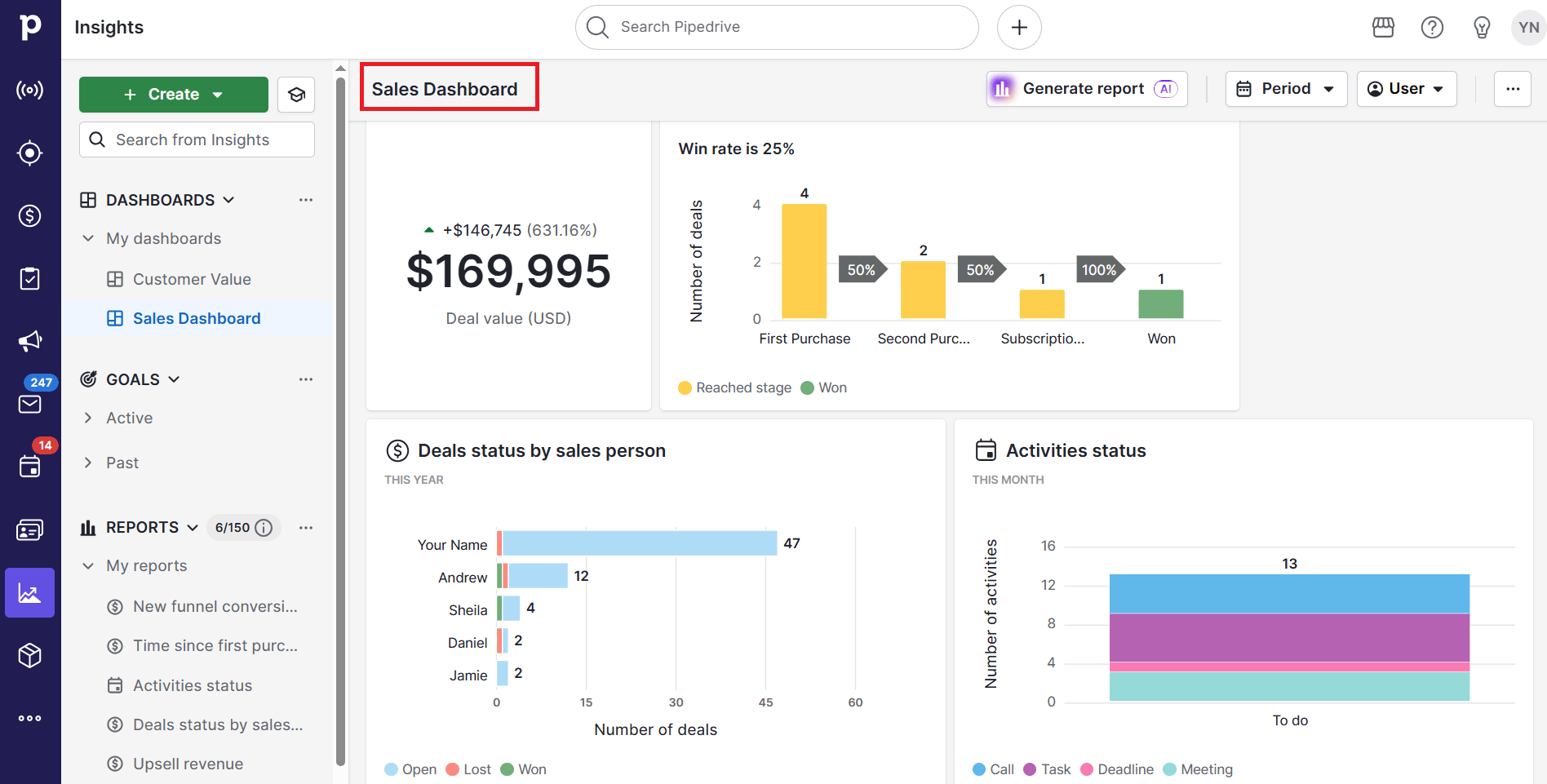
Use these dashboards to track sales performance, monitor team progress and quickly identify opportunities to improve your CRM strategy.
Benefits of a CRM strategy for SMBs
A well-defined CRM strategy helps SMBs strengthen customer relationships, improve efficiency and drive long-term growth.
By aligning sales, marketing and customer service goals in one system, teams can deliver better customer interactions across every stage of the buying journey.
With a clear CRM strategy in place, SMBs can:
Improve customer retention. Centralize customer data to deliver timely, relevant communication and proactive support that builds loyalty.
Boost productivity. Automate routine tasks, streamline workflows and give teams more time to focus on strategic, high-value activities.
Enhance collaboration. Ensure every team member – from sales to support – has access to shared customer insights and real-time updates.
Increase profitability. Simplify lead management, shorten the sales lifecycle and uncover new cross-selling and upselling opportunities.
Strengthen data security. Protect sensitive customer information through structured data management and access controls.
A strong CRM strategy empowers SMBs to operate more efficiently, serve customers better and grow sustainably in competitive markets.
Why you should refine your CRM strategy over time
Refining your CRM strategy over time keeps it aligned with evolving customer needs, business goals and market conditions, maximizing efficiency and growth.
Unlike marketing project management or completing individual sales tasks, strategizing never ends. Even when you’re confident in the plan you’ve built, refine it as you learn from every success and failure.
A dynamic CRM strategy will empower you to:
Adapt to changing audience behaviors | Your audience is constantly evolving. Be open to changing how you interact with customers to ensure you meet them where they are and address their needs. Example: A CRM strategy that relied heavily on SMS communication may have kept contacts engaged 15 years ago, but now audiences might prefer messaging through other channels, such as WhatsApp. |
Uncover new opportunities | As you adapt your CRM strategy to fit existing customers’ needs, you’ll open your business up to new audiences too. Example: Say you notice customer engagement dropping on X (formerly Twitter). By building marketing strategies for other social media channels, you could target new markets to expand your customer base. |
Optimize sales and marketing efficiency | Data should inform all your sales and marketing activities. The more organized that data is, the faster your reps and marketers can act and the better their decision-making will be. Example: If you use automation to populate your CRM system with high-value lead data, salespeople won’t need to spend hours identifying potential customers or prioritizing which prospects to contact. |
By continuously refining your CRM strategy, your business stays agile, uncovers growth opportunities and ensures every customer interaction drives meaningful results.
3 real-world CRM strategy examples for inspiration
An effective CRM strategy fits your unique business needs and helps you build unbreakable relationships with your target customers.
However, studying what other customer-centric businesses do to succeed is a great way to gather ideas for your own CRM planning. With that in mind, here are three CRM strategy examples from brands that use Pipedrive.
1. Let’s Do It World turns its vast audience into a fully engaged community
Let’s Do It World (LDIW) organizes and promotes environmental cleanup events and has a huge, global audience to keep engaged.
People from 211 countries and territories participated in the organization’s initiatives in 2024 and 114 million people have taken part since 2018.
The success of LDIW’s biggest event, World Cleanup Day, relies heavily on the efforts of partners and leaders across the world. The organization relies on a CRM strategy to ensure these people always feel connected to LDIW and its mission.
LDIW uses Pipedrive to centralize its communication history with all of its community members. The platform serves as a single source of truth for paid employees and volunteers alike.
Integrations with other tools in LDIW’s tech stack minimize the administrative burden of campaign management.
LDIW’s CRM strategy example means that rather than investing time in data cleanup or syncing contact information across systems, the team can focus on what matters: encouraging audiences to participate in mission-critical events.
2. Accentuate keeps its team informed by centralizing contact data
Accentuate, a web design and marketing firm, started out using spreadsheets to manage lead and customer information.
These spreadsheets meant team members could never get a full or clear picture of their target audiences or where they were in the sales funnel.
Now, Accentuate uses CRM software as a central hub for customer knowledge. Since making the switch, the company has increased annual revenue 10 times over.
Storing data in one place ensures everyone is always informed. Sales, marketing and customer service teams can make decisions that contribute to stronger customer relationships.
3. Spark Interact accelerates agency growth by consolidating sales and marketing workflows
Spark Interact, a digital agency based in Australia, needed more visibility into its sales funnel.
The company wanted stronger links between inbound leads, outbound leads and actual revenue.
The agency adopted Pipedrive to unify its CRM, campaign management and reporting tools.
Using custom dashboards and automated workflows, the company got real-time insight into performance, shortened the lead-to-opportunity timeframe and improved conversion rates.
Consolidating activities in Pipedrive boosted Spark Interact’s annual revenue by 12% without expanding its sales team. With a centralized process engine driving leads, tasks and campaigns, Spark Interact’s CRM strategy keeps the team aligned and focused on growth.
Final thoughts
A well-defined CRM strategy helps SMBs strengthen customer relationships, improve team alignment and make smarter, data-driven decisions.
To get the most from your strategy, review and refine your approach regularly so it continues to reflect your goals, customers’ needs and how your teams work best.
Using CRM apps like Pipedrive makes it easier to put your strategy into action. Automate workflows, track customer interactions and visualize your sales pipeline to focus on what drives growth.
Try Pipedrive free for 14 days to see how it can support your CRM strategy, from closing deals faster to building lasting customer relationships.








